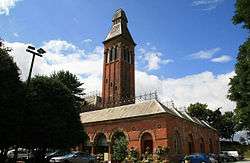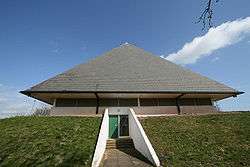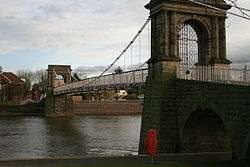City of Nottingham Water Department
The City of Nottingham Water Department (1912–1974), formerly the Nottingham Corporation Water Department (1880–1912), was responsible for the supply of water to Nottingham from 1880 to 1974.[1]
Early History 1696–1880
Original Nottingham Waterworks Company
The original Nottingham Waterworks Company, was established in 1693, extracting water from the River Leen by means of a water engine with a large water wheel. The difficulty of pumping water to the higher parts of the town took many years to resolve. Two reservoirs were created to increase the supply of piped water to the town.
Zion Hill Water and Marble Works
Another company, the Zion Hill Water and Marble Works was formed ca.1790. It drew water from two wells near Alfreton Road and Canning Circus using steam engines which also sawed marble and powered some lace machines. Part of the supply was piped to houses in the town. It had ceased to function independently by 1824.
Nottingham New Waterworks Company
The Nottingham New Waterworks Company opened new works at Brewhouse Yard and Scotholme Springs (Basford) in Sherwood in 1826.
Trent Waterworks Company
In 1828 the Trent Waterworks Company was formed and in 1831 a new waterworks was opened at Trent Bridge. The impetus behind the improvements was the engineer Thomas Hawksley working for the Trent Waterworks Company. It extracted water from the River Trent and filtered and pumped it, delivering Britain's first high pressure 'constant supply',[2] preventing contamination entering the supply of clean water mains.[3]
Writing in 1935, J. Holland Walker reports
At the northern end of Trent Bridge, about on the site now occupied by the Town Arms Hotel, stood the old water works of Nottingham, which were such a charming feature of the landscape forty or fifty years ago, but which have now completely disappeared. A tall brick chimney, mellowed from its first rawness by age, and a grove of well-grown trees marked the old pumping station. There was a great settling tank, or reservoir, receiving water from the river Trent, which reservoir occupied both sides of the road, and a faint echo of which remains in the gardens between Messrs. Turney's works and the river. After this water had passed the filter-bed it was pumped to the reservoir on the eastern side at the upper end of Park Row. For many years this reservoir was open, and surrounded by trees, and was an extremely picturesque object, but some forty or fifty years ago it was covered over by a great concrete roof, which has remained until 1925, when it was broken with considerable difficulty, and the site devoted to the erection of an out-patients' department for the Nottingham General Hospital. These waterworks at Trent Bridge and also the reservoir on Park Row, were erected in 1831, and we are informed that the water was forced through the mains from Trent Bridge by an engine of forty horse power, at the rate of ten hogsheads per minute. The reservoir is a hundred and thirty feet above the Trent, and in 1850 the water distributed from it through about twelve miles of pipe to the neighbouring districts.[4]
Nottingham Waterworks Company



Following the Nottingham Water Act of 1845, the three companies were merged into one body, known as the Nottingham Waterworks Company.
Further expansion included:
- a reservoir on Park Row, Nottingham, and a pumping house on the Ropewalk in Nottingham in 1850
- the Bagthorpe works and Basford Pumping Station in 1857 with two 60 hp (45 kW) compound Beam Engines by R and W Hawthorn of Newcastle upon Tyne in 1857 and was enlarged in 1868 by the addition of a 80 hp (60 kW) single cylinder. (One Hawthorn engine is now preserved at Wollaton Park Industrial Museum, maintained by the Arkwright Society).
- Bestwood Pumping Station (1871)
New reservoirs were built at:
- St. Ann's – Belle Vue (1850)
- Mapperley Hill (1857)
- Redhill (1871)
- Papplewick (1880)
The Ropewalk Pumping Station had to be disused around 1880.
Nottingham Corporation Water Department
The Nottingham Improvement Act of 1879 empowered Nottingham Corporation to take over the Nottingham Waterworks Company. Takeover was completed on 25 March 1880 with the formation of the Nottingham Corporation Water Department.
On 25 May 1881 the Water Department invited the members of the Corporation to inspect the works of the important water undertaking recently acquired by the town. From the public offices in Albert Street the large party left using private trams supplied by the Nottingham and District Tramways Company Limited for Trent Bridge. As the day progressed so the party moved on to and around the various sites. From the Trent works they travelled by tram again and then walked to the Castle Works. From there the Park Row reservoir was visited and another short walk took them to the Sion Hill (Canning Circus) Works. From the top of the Derby Rd, nearby, the tram cars were used for the journey to the Scotholme Springs. The party then moved on by carriage to see Bestwood Pumping Station.
Immediately work started on Papplewick Pumping Station (which opened in 1884) and new works on Mapperley Plains. When Papplewick Pumping Station came on line in 1884, the Scotholme, Trent Bridge, and Brewhouse Yard works were closed.
A sewerage works was opened at Stoke Bardolph in 1880 at a cost of £150,000 (equivalent to £13,466,227 in 2015),[5].
Further pumping stations were opened at Burton Joyce, and Boughton Pumping Station in 1905. In 1906 Wilford Suspension Bridge was opened to transport water over the River Trent to the Wilford Hill reservoir.
The five pumping stations now owned by the corporation drew water from the bunter sandstone and delivered it to covered reservoirs in the city, from where it was delivered by gravity to domestic and industrial consumers.
City of Nottingham Water Department

The Nottingham Corporation Waterworks was renamed the City of Nottingham Water Department in 1912.
The Derwent Valley Water Act of 1899 allowed the Derwent Valley Water Board to supply Nottingham, Sheffield, Leicester and Derby from newly constructed reservoirs in the Derwent Valley in Derbyshire. Water from this source started in 1916.
The total quantity of water distributed during the year ended March 1939 was 5,331 million imperial gallons (24,240,000 m3).
The Nottingham Corporation Act 1938 authorised the construction of two new pumping station, three new reservoirs, a water tower and trunk mains.[6] The whole of the works was estimated to cost £400,000 and was scheduled for completion by 1948, but the project was interrupted by World War II. Between 1945 and 1969, with revised plans five further borehole stations were built at Rufford, Lambley, Halam, Markham Clinton (1959–1960) and Ompton (1965–1968).
From 1961 a programme of replacing steam power with electric pumps was undertaken:
- 1961 the third steam engine at Basford
- 1963 the remaining steam engines at Basford
- 1966 Bestwood Pumping Station
- 1967 Boughton Pumping Station
- 1969 Papplewick Pumping Station
In 1967 a new reservoir and treatment works was built at Church Wilne extracting water from River Derwent.
By 1969, 23 million imperial gallons (100,000 m3) of water were supplied daily from boreholes and pumping stations to the Nottingham area.[7]
Privatisation
The City of Nottingham Water Department existed until 1974 when, under the Water Act 1973, its responsibilities were transferred to the Severn Trent Water Authority which was privatised in 1989 and is now Severn Trent Water.
See also
References
- ↑ A Centenary History of Nottingham. John Beckett. Manchester University Press. 1997. ISBN 0-7190-4001-9
- ↑ Proceedings of the Institution of Mechanical Engineers. The Institution of Mechanical Engineers (Great Britain) 1914
- ↑ "Nottingham Water Supply – history". Archived from the original on 2007-08-09.
- ↑ An Itinerary of Nottingham. J. Holland Walker. 1935
- ↑ UK CPI inflation numbers based on data available from Gregory Clark (2016), "The Annual RPI and Average Earnings for Britain, 1209 to Present (New Series)" MeasuringWorth.
- ↑ Nottingham. Official Guide. Tenth Edition
- ↑ http://www.nottingham.ac.uk/ManuscriptsandSpecialCollections/Learning/HealthHousing/Theme2/WaterSupply.aspx
